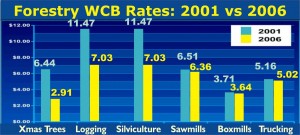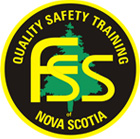WCB Rates
WCB Safety Incentive Program Makes Rates More Responsive

The forestry sector has reduced its injury rate and improved return to work performance, and the resulting lower assessments have saved employers $4 million in premiums.
Workplace injury insurance is now like other insurance – those employers with poor safety and return to work records will see their rates go up, while those who improve their records will see their rates go down.
Under the WCB’s new Safety Incentive Program, the experience rating system becomes even more responsive to injury prevention and return to work performance improvements on the part of employers.
The Safety Incentive Program has a simple principle: Companies that improve their safety and return to work records will see their WCB rates go down faster, while those with poor experience relative to their industry will see their rates increase.
Of 18,000 assessed employers, 275 received a surcharge warning notice with their packages in August.
Employers whose cost experience is consistently at least 200 percent worse than their peers will face surcharges that will increase annually, unless they take action to improve their safety and return to work performance. Employers will receive two warnings, giving them time to improve before the surcharge comes into effect in 2008.
The Nova Scotia Forestry Industry has proven the theory of the Safety Incentive Program. Through a strong commitment to safety and injures workers’ early and safe return to work and preventing injuries, WCB assessment rates for forestry has gone down 40 percent in the last five years resulting in $4 million savings for forestry employers.
“About eight years ago, the Forest Products Association of Nova Scotia, the leaders in our industry, realized the human and economic toll of workplace injuries was getting out of hand and something had to be done.” said Tommy Harper, Manager of the Forestry Safety Society of Nova Scotia.
“We had safety guidelines in place and then established the Forestry Safety Society to deliver quality training programs to ensure safe work environments. With encouragement from some big players in the industry, more menbers began to see the benefits. Our employers responded well, and given these new rates, it looks like our efforts have been successful.
